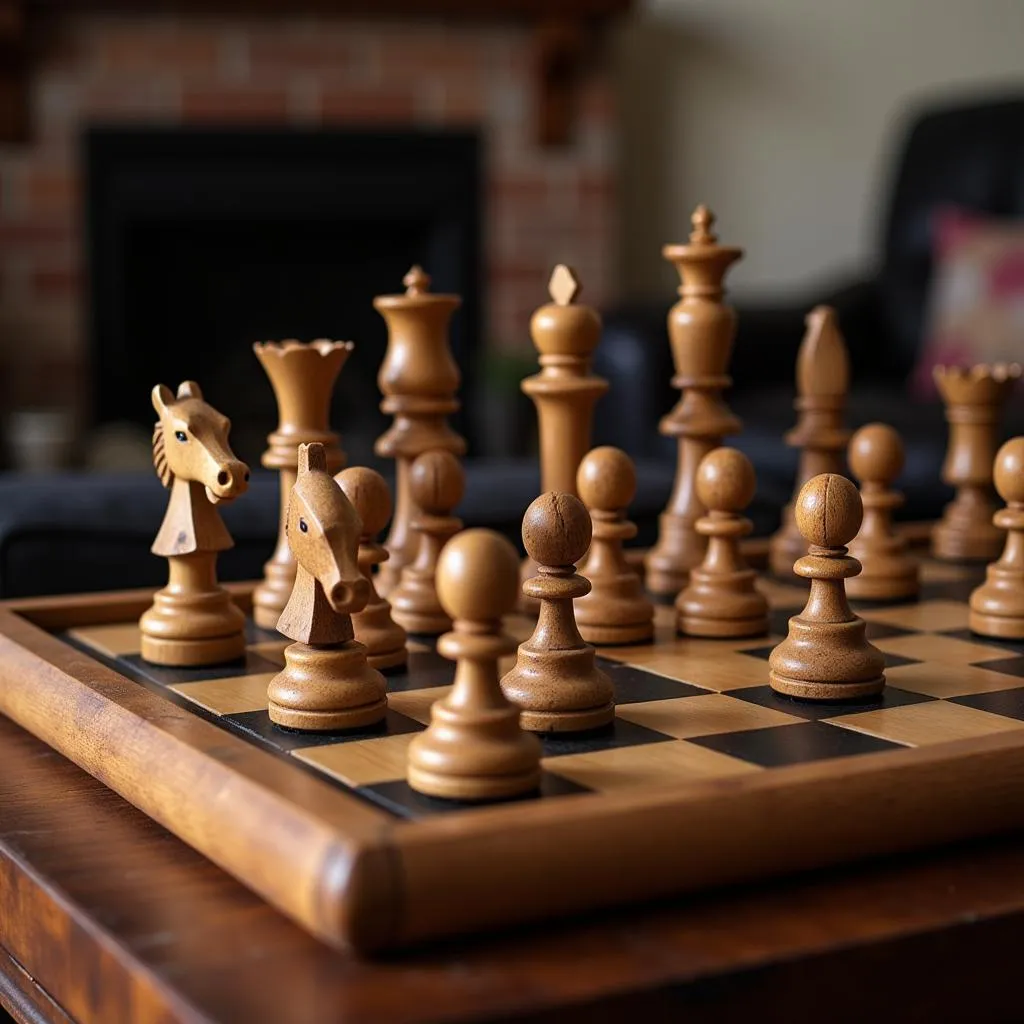Unraveling the History and Beauty of the African Chess Set
The African Chess Set is more than just a game; it’s a captivating blend of history, artistry, and cultural significance. Unlike the standardized Staunton chess set commonly seen today, African chess sets showcase the continent’s diverse heritage through unique designs and materials. These sets offer a glimpse into the artistry and traditions of various African cultures, turning a strategic battle of wits into a visual feast.
The Origins and Evolution of African Chess Sets
The history of chess sets in Africa is interwoven with the journey of the game itself. While the exact origins of chess remain debated, most historians agree that its precursor, Chaturanga, originated in India no later than the 6th century CE. From India, the game traveled along trade routes, reaching Persia and eventually North Africa by the 7th century. As chess spread throughout Africa, it was embraced by different cultures, each imbuing the game with their own artistic sensibilities and regional resources.
Early African chess sets were often simple, crafted from readily available materials like carved wood, clay, or bone. Over time, these sets evolved, reflecting the growing sophistication of different African societies. Trade with other regions also influenced design elements, with Islamic geometric patterns and motifs finding their way into North African sets.
A Tapestry of Styles: Exploring Regional Variations
One of the most captivating aspects of African chess sets is the sheer diversity of styles found across the continent. From the intricate metalwork of the Ashanti people in Ghana to the vibrant beadwork of the Maasai in Kenya, each region boasts unique aesthetics and craftsmanship.
West African Chess Sets
West Africa is renowned for its skilled artisans who excel in bronze casting, woodcarving, and weaving. This region is home to some of the most striking and intricate African chess sets:
- Ashanti Chess Sets: Originating from Ghana, these sets are famed for their elaborately cast bronze figures depicting warriors, hunters, and royal figures.
- Yoruba Chess Sets: Crafted by the Yoruba people of Nigeria, these sets often feature figures carved from wood and adorned with intricate details and vibrant colors.
East African Chess Sets
East African chess sets showcase the region’s rich tradition of beadwork, woodcarving, and soapstone sculpting:
- Maasai Chess Sets: These sets are instantly recognizable for their use of colorful beads and intricate beadwork patterns. The pieces often depict Maasai warriors, their families, and wildlife.
- Makonde Chess Sets: Hailing from Tanzania and Mozambique, Makonde artists are known for their expressive ebony carvings. Makonde chess sets feature abstract figures with exaggerated features.
Beyond Aesthetics: Cultural Significance and Symbolism
 African Chess Set: Cultural Significance
African Chess Set: Cultural Significance
African chess sets are much more than just decorative items; they hold deep cultural significance and often embody symbolic meanings.
- Social Status and Prestige: Owning an elaborately crafted chess set was often a symbol of wealth and social standing, especially among some West African cultures where kings and chiefs commissioned sets made from precious materials.
- Storytelling and History: Many African chess sets serve as a form of visual storytelling, depicting historical events, important figures, or cultural myths and beliefs through their design and characters.
- Community and Recreation: Beyond their artistic value, chess sets played a vital role in fostering social interaction and entertainment within communities, bringing people together for friendly competition and strategic challenges.
The Enduring Appeal of African Chess Sets
 Modern African Chess Set Design
Modern African Chess Set Design
In a world saturated with mass-produced goods, African chess sets retain a unique appeal. They offer:
- A Connection to Heritage: For many people of African descent, owning an African chess set is a way to connect with their heritage and celebrate the artistry of their ancestors.
- Uniqueness and Individuality: Unlike mass-produced chess sets, each African chess set is unique, reflecting the individual style and skill of the artisan who created it.
- A Conversation Starter: The distinctive beauty of an African chess set is sure to spark conversation and pique the interest of guests, offering a glimpse into the rich cultures of Africa.
Choosing Your African Chess Set
Whether you are a seasoned chess player or simply appreciate beautiful and culturally significant objects, an African chess set can make a captivating addition to your home. When choosing a set, consider the following:
- Regional Style: Explore the diverse styles from different parts of Africa and select one that resonates with your aesthetic preferences.
- Materials: African chess sets are crafted from a wide range of materials, each with its own unique beauty and durability.
- Craftsmanship: Look for sets that showcase fine craftsmanship and attention to detail.
Conclusion
The African chess set is a testament to the continent’s rich cultural tapestry, offering a fascinating blend of artistry, history, and strategic gameplay. From the intricate bronze figures of West Africa to the vibrant beadwork of East Africa, these sets transcend their function as game pieces to become cherished works of art and powerful symbols of heritage. Whether you are drawn to their aesthetic beauty, cultural significance, or simply the joy of the game, an African chess set is an investment that can be treasured for generations to come.
FAQs
-
What is the average cost of an African chess set? The price can vary greatly depending on the materials, craftsmanship, and region of origin. Simple sets can start from around $50, while intricately carved or cast sets can range from several hundred to thousands of dollars.
-
Where can I buy authentic African chess sets? You can find them at specialty retailers, African art galleries, online marketplaces like Etsy, and fair trade organizations that support African artisans.
-
How do I care for my African chess set? The care instructions will depend on the materials used. Generally, dusting the pieces regularly and storing them in a cool, dry place will help preserve their beauty.
-
Are African chess sets suitable for children? While some sets are delicate and better suited for display, others are sturdy enough for gameplay. Consider the materials and craftsmanship when choosing a set for children.
-
What are some popular African chess set styles? Some popular styles include Ashanti bronze sets, Yoruba carved wood sets, Maasai beaded sets, and Makonde ebony sets.
Explore More
- For a captivating look at African cinema, check out these African based English movies.
- Discover the rich history of Africa through film with this list of African history movies in Hindi.
- Immerse yourself in the beauty of the African landscape with these stunning African forest movies.
Need Assistance?
We are here to help! For any inquiries or assistance in finding the perfect African chess set for you, please don’t hesitate to contact us:
Phone: +255768904061
Email: [email protected]
Address: Mbarali DC Mawindi, Kangaga, Tanzania.
Our dedicated customer care team is available 24/7 to assist you with any questions or concerns you may have.

